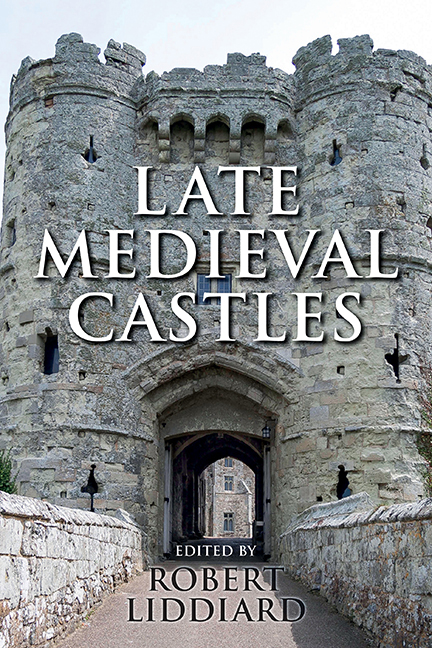Book contents
- Frontmatter
- Contents
- List of Illustrations
- Acknowledgements
- Editor's Preface
- List of Abbreviations
- A Note on the Text
- Introduction
- 1 Fourteenth-Century Castles in Context: Apotheosis or Decline?
- 2 Architects, Advisors and Design at Edward I's Castles in Wales
- 3 The Courtyard and the Tower: Contexts and Symbols in the Development of Late Medieval Great Houses
- 4 Castle Planning in the Fourteenth Century
- 5 Meaningful Constructions: Spatial and Functional Analysis of Medieval Buildings
- 6 Mota, Aula et Turris: The Manor-Houses of the Anglo-Scottish Border
- 7 Lulworth Castle, Dorset
- 8 A Scottish Problem with Castles
- 9 Structural Symbolism in Medieval Castle Architecture
- 10 Specimens of Freedom to Crenellate by Licence
- 11 Some Analysis of the Castle of Bodiam, East Sussex
- 12 English Castles in the Reign Of Edward II
- 13 Castles of Ward and the Changing Pattern of Border Conflict in Ireland
- 14 The Donjon Of Knaresborough: The Castle As Theatre
- 15 The Architecture of Arthurian Enthusiasm: Castle Symbolism in the Reigns of Edward I and his Successors
- 16 Medieval Ornamental Landscapes
- 17 Otherworld Castles in Middle English Arthurian Romance
- Guide to Further Reading
- Index
3 - The Courtyard and the Tower: Contexts and Symbols in the Development of Late Medieval Great Houses
Published online by Cambridge University Press: 29 April 2017
- Frontmatter
- Contents
- List of Illustrations
- Acknowledgements
- Editor's Preface
- List of Abbreviations
- A Note on the Text
- Introduction
- 1 Fourteenth-Century Castles in Context: Apotheosis or Decline?
- 2 Architects, Advisors and Design at Edward I's Castles in Wales
- 3 The Courtyard and the Tower: Contexts and Symbols in the Development of Late Medieval Great Houses
- 4 Castle Planning in the Fourteenth Century
- 5 Meaningful Constructions: Spatial and Functional Analysis of Medieval Buildings
- 6 Mota, Aula et Turris: The Manor-Houses of the Anglo-Scottish Border
- 7 Lulworth Castle, Dorset
- 8 A Scottish Problem with Castles
- 9 Structural Symbolism in Medieval Castle Architecture
- 10 Specimens of Freedom to Crenellate by Licence
- 11 Some Analysis of the Castle of Bodiam, East Sussex
- 12 English Castles in the Reign Of Edward II
- 13 Castles of Ward and the Changing Pattern of Border Conflict in Ireland
- 14 The Donjon Of Knaresborough: The Castle As Theatre
- 15 The Architecture of Arthurian Enthusiasm: Castle Symbolism in the Reigns of Edward I and his Successors
- 16 Medieval Ornamental Landscapes
- 17 Otherworld Castles in Middle English Arthurian Romance
- Guide to Further Reading
- Index
Summary
The final two centuries of the Middle Ages are conventionally considered a period in which castles and castle-building were in decline. The ‘Decline of the Castle’ and ‘Decline’ are the titles of chapters dealing with this period in books written by Allen Brown. In each case the contrast with what went before is strongly emphasised: the previous chapters are named ‘The Perfected Castle’ and ‘Apogee’. In the same vein, these final centuries after c.1300 have been described as ‘the period of decline in use but survival in fantasy’ in an authoritative account, significantly entitled The Decline of the Castle. Our view of this period is different. We consider that the castles of the later Middle Ages show a steady development, not a decline, and the main elements of that development can already be traced in buildings of the ‘Golden Age’.
Our themes, the symbols of the courtyard and the tower, are visible in the arrangements of 1283 at Caernarvon. The King's Gate of this castle was a novel and complex affair placed to divide the interior of the castle into two halves. The entrance passageway beyond the central polygonal chamber directed traffic at right angles westwards into a lower courtyard. This contained the principal hall and its services, and a series of accommodation lodges in mural towers. All this is a conventional arrangement: what is much odder is that this lower courtyard contained also the visual focus of the castle, the Eagle Tower, emphasised particularly from the outside by its greater size and by its termination in a triple crown of turrets, originally given additional importance by the placing of sculptures of eagles on its battlements. The purpose of this striking design is a strong statement of the fulfilment of the Dream of Macsen Wledig in the person of Edward I and his son, a statement whose propaganda must have been obvious to the defeated Welsh aristocrats. The symbolism of all this has been examined by Dr Arnold Taylor, who further identified the Eagle Tower as the intended residence of the king's Justiciar of Wales and first constable of the castle, Edward's loyal supporter Otto de Grandson, and his conclusions seem now to be accepted.
- Type
- Chapter
- Information
- Late Medieval Castles , pp. 61 - 78Publisher: Boydell & BrewerPrint publication year: 2016



